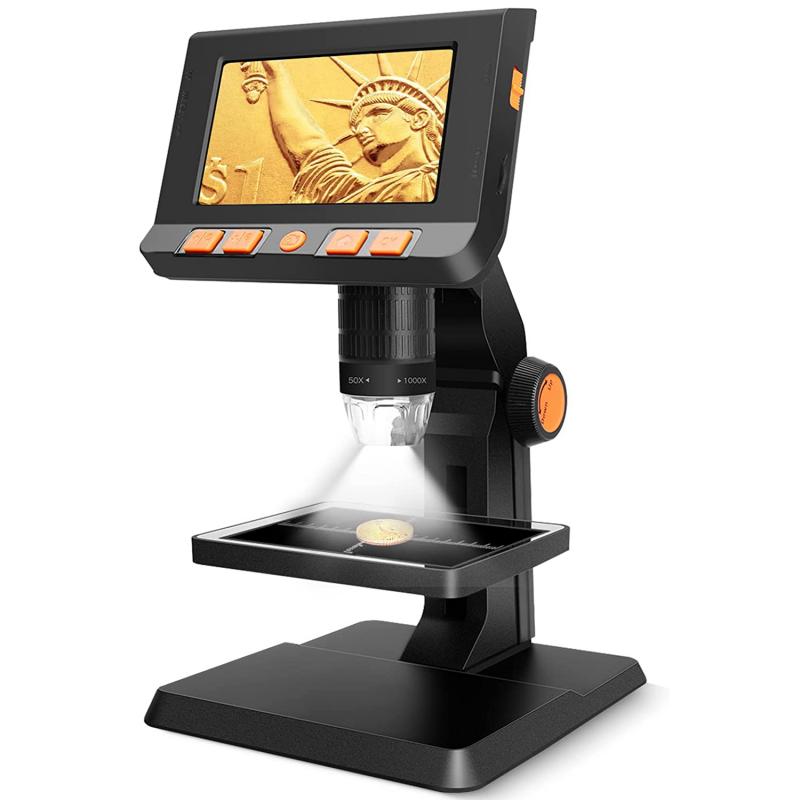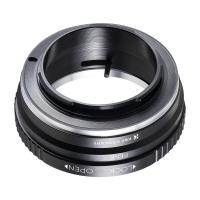What Is Resolution On A Light Microscope ?
Resolution on a light microscope refers to the ability of the microscope to distinguish two closely spaced objects as separate entities. It is a measure of the level of detail that can be observed and is determined by the wavelength of light used and the numerical aperture of the lens system. The resolution of a light microscope is limited by the diffraction of light, which causes the light waves to spread out as they pass through the lens. As a result, objects that are closer together than the resolution limit of the microscope will appear blurred or indistinguishable. The maximum resolution achievable by a light microscope is approximately half the wavelength of the light used. Various techniques, such as using shorter wavelength light or increasing the numerical aperture, can improve the resolution of a light microscope.
1、 Optical Resolution: Limit of distinguishable detail in an image.
Optical resolution refers to the limit of distinguishable detail in an image produced by a light microscope. It is a measure of the microscope's ability to distinguish two closely spaced objects as separate entities. The resolution of a light microscope is determined by the wavelength of light used and the numerical aperture of the lens system.
The concept of optical resolution was first introduced by Ernst Abbe in the late 19th century. According to Abbe's theory, the maximum resolution achievable by a light microscope is approximately half the wavelength of the light used. This means that the smallest distance between two points that can be resolved is about half the wavelength of light.
However, in recent years, advancements in microscopy techniques have pushed the limits of optical resolution beyond what was previously thought possible. This has been made possible by the development of super-resolution microscopy techniques such as stimulated emission depletion (STED) microscopy, structured illumination microscopy (SIM), and single-molecule localization microscopy (SMLM).
These techniques utilize various principles to overcome the diffraction limit of light and achieve resolutions beyond the traditional limit. For example, STED microscopy uses a combination of laser beams to selectively deactivate fluorescence emission from certain regions, resulting in a smaller effective point spread function and improved resolution. SMLM techniques, on the other hand, rely on the precise localization of individual fluorophores to reconstruct a high-resolution image.
With these advancements, optical resolution in light microscopy has reached the nanoscale level, allowing researchers to visualize cellular structures and processes with unprecedented detail. This has opened up new avenues for studying biological systems and has led to significant discoveries in various fields, including cell biology, neuroscience, and immunology.
In conclusion, optical resolution on a light microscope refers to the limit of distinguishable detail in an image. While the traditional limit is determined by the wavelength of light, recent advancements in super-resolution microscopy techniques have pushed the boundaries of optical resolution, enabling researchers to visualize structures at the nanoscale level. These advancements have revolutionized the field of microscopy and have greatly contributed to our understanding of the intricate workings of biological systems.

2、 Numerical Aperture: Measure of light-gathering ability of a lens.
Resolution on a light microscope refers to the ability of the microscope to distinguish two closely spaced objects as separate entities. It is a measure of the microscope's ability to provide clear and detailed images by minimizing blurring and maximizing the level of detail that can be observed.
One important factor that affects resolution is the numerical aperture (NA) of the lens. Numerical aperture is a measure of the light-gathering ability of a lens and is determined by the lens design and the refractive index of the medium between the lens and the specimen. A higher numerical aperture allows for a greater amount of light to enter the lens, resulting in improved resolution.
The numerical aperture is calculated using the formula NA = n * sin(θ), where n is the refractive index of the medium and θ is the half-angle of the maximum cone of light that can enter the lens. By increasing the numerical aperture, the angle of light entering the lens increases, allowing for a greater level of detail to be captured.
Advancements in lens design and technology have led to the development of high numerical aperture lenses, such as oil immersion lenses, which can significantly improve the resolution of light microscopes. These lenses use a high refractive index oil between the lens and the specimen, increasing the numerical aperture and allowing for even finer details to be observed.
It is important to note that while numerical aperture is a crucial factor in determining resolution, it is not the only factor. Other factors, such as the wavelength of light used and the quality of the lens, also play a role in determining the overall resolution of a light microscope.
In recent years, there have been significant advancements in microscopy techniques that have pushed the limits of resolution beyond what was previously thought possible. Techniques such as super-resolution microscopy, which utilize fluorescent probes and complex algorithms, have allowed researchers to achieve resolutions beyond the diffraction limit of light. These techniques have revolutionized the field of microscopy and have enabled scientists to observe cellular structures and processes at an unprecedented level of detail.
In conclusion, resolution on a light microscope is determined by various factors, with numerical aperture being a key parameter. The numerical aperture of a lens determines its light-gathering ability and plays a crucial role in improving the resolution of a light microscope. Advancements in lens design and microscopy techniques have continuously pushed the boundaries of resolution, allowing for the observation of finer details and opening up new avenues of scientific discovery.

3、 Abbe's Diffraction Limit: Minimum resolvable distance between two points.
The resolution on a light microscope refers to its ability to distinguish two closely spaced objects as separate entities. It is a measure of the microscope's ability to provide clear and detailed images by minimizing blurring and maximizing the level of detail that can be observed.
One of the fundamental concepts related to the resolution of a light microscope is Abbe's Diffraction Limit. Proposed by Ernst Abbe in the late 19th century, it states that there is a minimum resolvable distance between two points that can be observed under a microscope. This limit is determined by the wavelength of light used and the numerical aperture of the microscope's objective lens.
According to Abbe's Diffraction Limit, the resolution of a light microscope is inversely proportional to the wavelength of light used and directly proportional to the numerical aperture of the objective lens. In simpler terms, shorter wavelengths of light and higher numerical aperture lenses result in better resolution.
However, it is important to note that Abbe's Diffraction Limit is a theoretical limit and does not account for other factors that can affect resolution, such as lens aberrations and sample preparation techniques. In recent years, advancements in microscopy techniques and technologies have pushed the boundaries of resolution beyond what was previously thought possible.
One such breakthrough is the development of super-resolution microscopy techniques, such as stimulated emission depletion (STED) microscopy and structured illumination microscopy (SIM). These techniques utilize various methods to overcome the diffraction limit and achieve resolutions beyond the traditional limits of light microscopy.
In conclusion, the resolution on a light microscope is determined by Abbe's Diffraction Limit, which defines the minimum resolvable distance between two points. However, with the advent of super-resolution microscopy techniques, the boundaries of resolution have been expanded, allowing for the observation of finer details and structures in biological samples.

4、 Rayleigh Criterion: Criterion for determining resolution based on Airy disks.
The resolution of a light microscope refers to its ability to distinguish two closely spaced objects as separate entities. It is a measure of the microscope's ability to provide clear and detailed images. The Rayleigh Criterion, also known as the Rayleigh limit or Rayleigh's criterion, is a fundamental concept used to determine the resolution of a light microscope based on Airy disks.
According to the Rayleigh Criterion, two point sources of light can be resolved if the central maximum of one Airy disk coincides with the first minimum of the other Airy disk. The Airy disk is the diffraction pattern formed by a point source of light passing through the lens of a microscope. It consists of a central bright spot surrounded by concentric rings of decreasing intensity.
The resolution of a light microscope is directly related to the wavelength of light used and the numerical aperture (NA) of the lens. The numerical aperture is a measure of the lens's ability to gather light and is determined by the lens's design and the refractive index of the medium between the lens and the specimen.
In recent years, advancements in microscopy techniques have pushed the limits of resolution beyond the Rayleigh Criterion. Techniques such as structured illumination microscopy (SIM), stimulated emission depletion (STED) microscopy, and super-resolution microscopy have allowed researchers to achieve resolutions beyond the diffraction limit of light. These techniques utilize various principles, such as patterned illumination or the manipulation of fluorescent molecules, to overcome the diffraction barrier and achieve higher resolution.
In conclusion, the resolution of a light microscope is determined by the Rayleigh Criterion, which is based on the concept of Airy disks. However, recent advancements in microscopy techniques have allowed researchers to surpass the diffraction limit and achieve higher resolutions, enabling the visualization of finer details and structures within biological samples.































There are no comments for this blog.